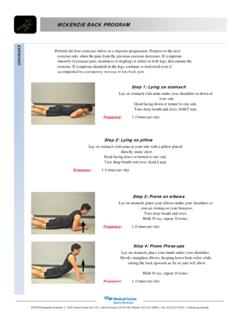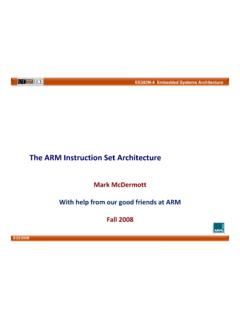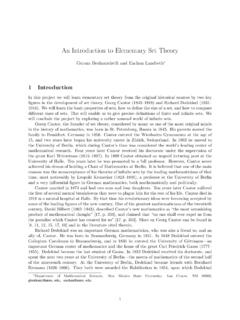Transcription of Problem Set 8 Solutions - Open Yale Courses
1 Problem Set 8 the real part, imaginary part, modulus, complex conjugate, and inverse of the following numbers: (i)23+4i,(ii)(3 + 4i)2, (iii)3+4i3 4i, (iv)1+ 2i1 3i, and (v)cos +isin .To find the quantities we are looking for, we need to put the complex number into the formz=a+bi. Then,the modulus is|z|= a2+b2, the complex conjugate isz =a bi, and the inverse can be found using theprevious quantities, as shown belowz 1=1z=1z(z z )=z |z|2(i)z=23 + 4i=23 + 4i(3 4i3 4i)=225(3 4i) = Re(z) =625, Im(z) = 825|z|=225 32+ 42=25z =225(3 + 4i)z 1=12(3 + 4i)(ii)z= (3 + 4i)2= 7 + 24i= Re(z) = 7, Im(z) = 24|z|= 72+ 242= 25z = 7 24iz 1= 1252(7 + 24i) = 1625(7 + 24i)(iii)z=3 + 4i3 4i=3 + 4i3 4i(3 + 4i3 + 4i)=125( 7 + 24i) = Re(z) = 725, Im(z) =2425|z|=125 72+ 242= 1z = 125(7 + 24i)z 1= 125(7 + 24i)(iv)
2 Z=1 + 2i1 3i=1 + 2i1 3i(1 + 3i1 + 3i)=14((1 6) +i( 2 + 3))= Re(z) =1 64, Im(z) = 2 + 34|z|=14 (1 6)2+ ( 2 + 3)2= 124= 32z =14((1 6) i( 2 + 3))z 1=13((1 6) i( 2 + 3))2(v)z= cos +isin = Re(z) = cos , Im(z) = sin |z|= cos2 + sin2 = 1z = cos isin z 1= cos isin the following pair of numbers, give their polar form, their complex conjugates, their moduli, product, thequotientz1/z2, and the complex conjugate of the +i 2z2= 3 iThe polar form of a complex number is given byz=Aei whereA=|z|and = tan 1Im(z)Re(z). Using this,z1=ei /4z2= 2e i /6z 1=1 i 2=e i /4z 2= 3 +i= 2ei /6|z1|= 1|z2|= 2z1 z2= 2ei( /4 /6)= 2ei /12z1z2=12ei( /4+ /6)=12ei5 /12(z1z2) =12e i5 the sum of the follwing in polar form:z1= 2ei /4z2= 6ei /3z1+z2= 2(cos /4 +isin /4) + 6(cos /3 +isin /3)= 2(1 2)(1 +i) + 6(12+i 32)=( 2 + 3)+i( 2 + 3 3)= 40 +12 2(1 + 3)eitan 1 2+3 3 2+3= De Moivre s Theorem, which states that(cos +isin )n= cosn +isinn.
3 This follows from takingthen-th power of both sides of Euler s theorem. Find the formula forcos 4 andsin 4 in terms ofcos andsin . GiveneiAeiB=ei(A+B)deducecos(A+B)andsin( A+B).We can find the formula for cos 4 and sin 4 by expanding (cos +isin )4and matching the real and imaginaryparts to cos 4 and sin 4 respectively.(cos +isin )4= cos4 + 4icos3 sin 6 cos2 sin2 4icos sin3 + sin4 = (cos4 6 cos2 sin2 + sin4 ) + 4i(cos3 sin cos sin3 )= cos 4 +isin 4 Matching the real and imaginary parts we see thatcos 4 = cos4 6 cos2 sin2 + sin4 sin 4 = 4 cos sin (cos2 sin2 ).
4 A particle attached to a spring executing a motionx=Asin( t+ )withA=.32m. Att= 0, it is atx= .07mand a velocity 2m/s. The total energy Find (i) , (ii)fthe frequency, (iii)kand (iv) m.(i) To find , look at the equation of motion forxatt= (t= 0) =x0=Asin(0 + ) = = sin 1(x0A)= sin 1( ).The arcsine of a number has two possible values becuase in a 2 period sine takes on all values between 1and 1 twice. In this case, we also know that we want cos to be negative becuase the velocity is negativeatt= 0. (If we choose the other value for sin 1 then we will get a negative.)
5 This is fine, it just meansthat our system is out of phase by .)In this case, sin 1( )= ; however, = + is also a valid answer. The second answeris in the third quadrent which is where both sine and cosine are negative, so I will take = (ii) To find the frequencyf, we need to look at the equation for the velocity. Differentiatingx(t) we find,v(t) =A cos( t+ ). Evaluatingv(t) att= 0 we find,v(0) =v0=A cos(0 + ) = =v0 Acos .The frequency,f, is given by /2 , sof=v02 Acos = 2m/s2 ( ) cos( )= (iii) When the spring is stretched to its maximum length, all of the energy in the system is potential energy,therefore,E=12kx2max.
6 The maximum distance occurs when|sin( t+ )|= ( )2= k= 109N/m(iv) The frequency of a spring is given by = km. Using this formula,m=k 2=109N/m(2 ( ))2sec 2= massmmoving horizontally at velocityv0on a frictionless table strikes a spring of force constantk. Itcompresses the spring and then bounces back with opposite velocity. Assuming no loss of energy anywhere findout (i) how long the mass is in contact with the spring and (ii) the maximum compression of the spring.(i) The frequency for a mass oscillating on a spring is given by = km.
7 The period of an oscillation isthenT=2 . In this Problem , the mass hits the spring atx= 0, compresses it, bounces back tox= 0, andthen leaves the spring. Therefore, the mass is in contact with the spring for half of a period. (We assumethe spring is massless, so it does not continue to stretch once the mass passesx= 0.) The total timetthemass is in contact with the spring ist=T2= mk.(ii) We can find the maximum compression of the spring by conservation of energy. When the mass just hitsthe spring, all the energy is kinetic.
8 At the maximum compression of the spring, all the energy is potentialenergy. Therefore,12mv20=12kA2= A=v0 mkwhereAis the maximum compression of the steel beam of massMand lengthLis suspended at its midpoint by a cable and executes torsional two massesmare now attached to either end of the beam and this reduces the frequency by10%, what ism/M?The frequency is proportional toI 1/2whereIis the moment of inertia. The moment if inertia of justthe steel beam isIi=M L2/12. Once you add the two masses at either end, the moment of inertia becomesIf=M L2/12 + 2m(L/2)2=M L2/12 +mL2/2.
9 Taking the ratio of the fto i, f i= = 112M L2112M L2+12mL2( )2=11 + 6mMmM=16( 1)= masses on the ends are each about 4% of the mass of the a solid disc, (say a penny), of massM, radiusR, standing vertically on a table. A tiny massmof negligible size is now glued to the rim at the lowest point. When disturbed, the penny rocks back and forthwithout slipping. Show that the period of the Simple Harmonic Motion isT= 2 3M : Find , the restoring torque per unit angular displacement. Whenm 0what happens toT. Explain inphysical will first compute the period starting from =I.
10 Take the pivot point to be the point on the table adistanceR away fromx= 0, wherex= 0 is the point of contact between the penny and the table before theoscillations. When the penny has rotated tox=R , as shown in Figure 1, the only force not acting at the pivotis the force of gravity on the massm. The moment of interia about the pivot point isI=Ipenny+ImwhereIpenny=32M R2by the parallel axis theorm andIm=m(R )2plus terms that depend on higher powers of .Because must be small in order to have simple harmonic motion, we will only keep terms that are proportionalto , but not 2or any higher powers.










![[Ch 6] Set Theory 1. Basic Concepts and Definitions](/cache/preview/c/e/2/4/1/3/7/e/thumb-ce24137e0a382875a0c9905ad219dbfc.jpg)


